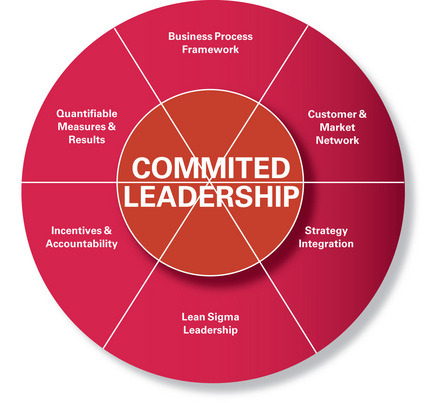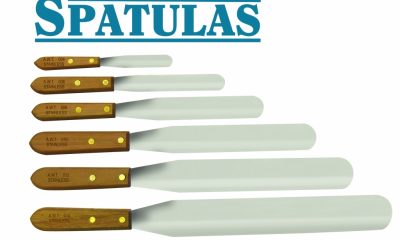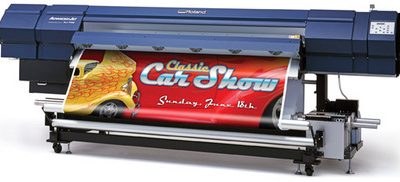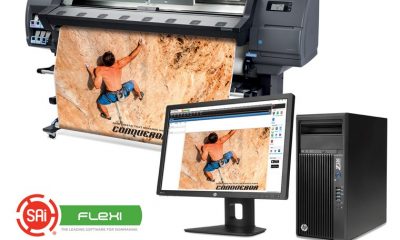Business & Industry
Published
17 years agoon

Lean manufacturing, Six Sigma, Kaizen, and Kanban are terms that, for most printers, bring on a sense of confusion, misunderstanding, and yes — even fear. Many of us believe we need some mystical Japanese teaching to be able to understand and apply the techniques that have led some of the Japanese auto makers to record years of performance and profitability. The truth of the matter is that although we may need some assistance in getting started, many printers already have the basic principles in place for being able to start down the road to lean manufacturing.
Lean manufacturing, Six Sigma, Kaizen, and Kanban are terms that, for most printers, bring on a sense of confusion, misunderstanding, and yes — even fear. Many of us believe we need some mystical Japanese teaching to be able to understand and apply the techniques that have led some of the Japanese auto makers to record years of performance and profitability. The truth of the matter is that although we may need some assistance in getting started, many printers already have the basic principles in place for being able to start down the road to lean manufacturing.
One of the traditional roadblocks associated with the journey of lean manufacturing is the misunderstanding that a company needs to hire an expert to initiate a companywide change of culture. I believe that this overwhelming challenge is what has held back our industry from beginning down the lean pathway. The need to hire a full-time, in-house lean expert can be a very expensive undertaking and is not necessary, given that consultants are available who can serve as experts for rent. Regardless of where the expert comes from, the more important challenge is understanding the companywide cultural change that comes with lean manufacturing.
Initiating and supporting change
What happens to a pond when the water doesn’t change? It becomes stagnant, life stops, and the pond dies. By nature, humans are very resistant to change. But in organizational life, few things are as constant as change itself. Markets change continually in a competitive world, and to survive, a business must be willing and ready to adapt to shifting economic and market conditions. If we fail to learn, adapt, adjust, and change, we can face commercial extinction. So the question must be asked and answered: How should we implement change?
Most companies don’t manage change, they impose it. Most change comes downhill from management. Change is often done using a top-to-bottom process, making employees feel like they have been acted upon, rather than being active participants. A leader’s role is to manage the change process by providing order, structure, and direction.
Fear of the unknown is one of the major barriers to change. This fear can be diffused through open discussion and successful improvement events. Employees will go along with change more readily if they feel responsible for its implementation. Few people oppose something they helped develop. Employees’ involvement in successful endeavors will motivate others in the facility to join the journey and begin to implement change on their own. Ask employees for their time, ideas, and suggestions to make certain that a positive environment for change is created. Change is best done through reasonable increments and initial successes. Let people be active participants and become responsible for the new way of doing things. Ten of the most important words that can be stated when it comes to change are if it is to be, it is up to me. Break down the change process into as many victories as possible without losing sight of the goal of maintaining a steady pace on the road to change and success.
We can see that to begin change, the persons who are asked to change must take ownership of that change. The best way to accomplish this is twofold. The first component is company leadership needs to lead by example and show support of the process (Figure 1). This is easily seen by bringing in new ideas along with the people who can guide the company on its journey. The second component is success. A past mentor of mine once shared with me a great analogy. When an African bushman who is staring at an elephant that is going to be his dinner was asked, “How are you going to eat all that?” the bushman replied, “One bite at a time!”
Impact assessment
Where should you start? You should start with something called a LeanSigma Impact Assessment. A trained consultant will visit your facility for one to two days and will use various tools and observational techniques to analyze your company’s current state and way of doing work. This approach also allows you to ask the consultant what the cost is before you commit. Some of the methods used to gather the data needed for the impact assessment follow.
Advanced colorimetric analysis This is a system by which a trained consultant will use color-data-gathering devices to obtain numerical verification of the print production process’s ability to control and achieve accurate color from conception to completion. An example of the types of tests performed during this analysis is a line dot angle test, which is done to ensure proper dot reproduction and line-screen optimization.
Productivity-improvement analysis The involves the use of numerous methodologies to observe, evaluate, and define the current state of productivity. Various statistical-analysis tools will be used to identify where the bulk of time is spent and clearly state where productivity opportunities exist. Among the tools the trained consultant could use are time study, spaghetti diagrams, load-leveling diagrams, and 5S (sort, straighten, shine, standardize, and sustain) evaluations. A non-subjective view of the process will use define, measure, analyze, improve, control concepts to see the actual reason for productivity slow downs and provide data to validate the findings. The immediate benefits to the company can be seen in improvements such as increased production flexibility, increased throughput, improvements in on-time and in-full delivery, and better internal and external communication.
Labor-optimization analysis Several methodologies are used to observe, evaluate and define the current state of labor utilization. Various statistical-analysis tools will be used to identify where the bulk of time is spent and clearly state where labor-improvement opportunities exist. Among the tools the trained consultant could use are time study, spaghetti diagrams, load leveling, cause & effect matrix, control charts, and 5S evaluations.
Waste-reduction analysis There are seven kinds of waste: overproduction, waiting times, transportation and handling, useless or excess inventories, production processes, useless motions, and scrap and defects. A range of methodologies are used to observe, evaluate, and define the current state of corporate waste. A variety of statistical-analysis tools also are applied to identify where the bulk of time is spent and clearly state where waste can be reduced. Among the tools the trained consultant could use are time study, spaghetti diagrams, process capability/process capability index, control charts, and 5S evaluations. New techniques, such as kanban and visual inventory (methods that rely on visual cues to pull materials and goods through the production process at the pull of customer demand), may be utilized to create a more streamlined production system.
Lean in action
Completing an impact assessment or similar analysis will help you identify targets for improvement. In the early stages, the opportunities for improvement can be considered low-hanging fruit, due to the relative ease with which they’re identified and harvested. These opportunities are then examined using a non-subjective analysis method, and decisions are made about which of these potential projects best aligns itself with the future corporate goals and existing values. Let me share a case study that illustrates the power of these impact assessments and the subsequent projects.
On a recent visit to a large- and medium-format P-O-P printer the opening discussion with their vice president of operations revealed that they had a goal of reducing setup time, thereby opening up more press time and ultimately leading to an increase in sales that would help them meet their growth target of 10% in 2008. Another strategic goal they had for 2008 was reducing the amount of re-work jobs and goods lost or damaged in the assembly/packing area.
The first part of the impact assessment was to gather data. These data were then reviewed by subject matter experts to best decide the course of action in accordance with corporate goals and the need for successful projects. Methods used to gather the data included a time study, spaghetti diagram, 5S evaluations, and a small process map. The actual findings of the time study are presented in Table 1. As we can see, the press crew spends a large amount of time looking for product (ink, screens, and tools), as well as cleaning up from the previous job.
One of the fundamentals of lean manufacturing that can be applied to the printing world is the concept of value added time (VAT). By definition, the term refers to a process that changes the form or function of an object. So in our case study, VAT is only that time when the press is printing onto the substrate — all the other time is non-value-added time. It is apparent from the time study that 117:15 minutes per changeover has a lot of room for improvement.
Another data-analysis tool is the spaghetti diagram. It’s used to collect the distance a person (or people) travels in a specific task or time frame. The diagram shown in Figure 2 represents the motions that the lead press operator makes in production. Following the operator around with a Lufkin measuring wheel during a shop visit revealed that he alone travels in excess of 4378 feet during an average print run.
The term 5S is another that companies hear quite often but sometimes have a slight difficulty in grasping conceptually. 5S is a method to improve and sustain the workplace organization. It represents the five disciplines for maintaining a visual workplace (visual controls and information systems). These are sort, straighten, shine, standardize, and sustain. These are foundational to continual improvement and a manufacturing strategy based on lean manufacturing (waste removing). The benefits of a 5S Program could be any or all of the following: reduction in clutter, reduction in the time it takes to look for tools and equipment, making sure there’s a place for everything and everything is in its place, and improving how the operation appears to customers. A lean operation strives to be tour-ready at all times, which has the added benefit of creating pride in the workplace. A perfect score in a 5S assessment is 5, so we can see in Table 2 that, with a score of 0.4, the company has a lot of room for improvement.
The goal is to create a changeover sequence that eliminates time and distance traveled. Let’s begin with the time study (Table 1). By using various lean techniques we can estimate a conservative reduction of 66:00 minutes. The press studied has a burden rate of $305.00 per hour. Potential amount saved per changeover could be $335.50. With an average daily job docket of five jobs per day and a five-day work week, we can calculate an $8387.50 of available press time created. Using a 50-week-peryear standard, we see that this single project can create a potential of $419,375.00 of press time that can be sold, creating opportunities to service new and existing clients. This project can be repeated on other presses in the facility, creating an even larger press capacity for possible sales.
The company on which this case study is based will have the chance to open a capacity of more than $800,000 in press time alone. With additional projects identified in areas of both manufacturing and service operations, we can see the low-hanging fruit is available and ready.
With a success such as this under their belt, the manufacturing staff will sustain the progression and take pride in their own victories. Their motto going forward will be “Work smarter, not harder,” and the staff will be instrumental in creating a system that is sustainable and will continue to drive out waste.
You can go lean
Does lean manufacturing work in the printing industry? Yes! But try it before you buy it. Get your people excited about it through some successful projects. You will never look back. By choosing the correct opportunities and creating a success story that involves your entire staff, you can enjoy a winning journey to lean manufacturing. Just like saving money for retirement, the key to lean implementation is to start small, early, and make contributions regularly.
Les deHamer is a Chromatix consultant for Nazdar Consulting Services. He has 23 years of experience in the printing and manufacturing industries and is a Six Sigma Black Belt trained at Motorola University. Certified in lean manufacturing methodologies, he has expertise in color management, prepress, quality assurance, and workflow-management systems.

Subscribe

Magazine
Get the most important news
and business ideas from Screenprinting Magazine.
Most Popular
-

 Case Studies2 months ago
Case Studies2 months agoHigh-Density Inks Help Specialty Printing Take Center Stage
-

 Art, Ad, or Alchemy2 months ago
Art, Ad, or Alchemy2 months agoF&I Printing Is Everywhere!
-

 Andy MacDougall2 months ago
Andy MacDougall2 months agoFunctional and Industrial Printing is EVERYWHERE!
-

 Columns3 weeks ago
Columns3 weeks ago8 Marketing Mistakes Not to Make When Promoting Your Screen Printing Services Online
-

 Editor's Note2 weeks ago
Editor's Note2 weeks agoLivin’ the High Life
-

 Thomas Trimingham2 months ago
Thomas Trimingham2 months ago“Magic” Marketing for Screen Printing Shops
-

 Marshall Atkinson2 weeks ago
Marshall Atkinson2 weeks agoHow to Create a Winning Culture in Your Screen-Printing Business
-

 News & Trends1 month ago
News & Trends1 month agoWhat Are ZALPHAS and How Can You Serve Them in Your Print Business?






